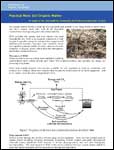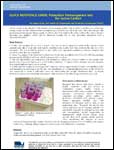Organic Matter
Decomposition | Forms and Function | Management of Soil Organic Matter | Carbon Cycle
Organic matter is critical for soil health and for soil productivity.
- Provides energy for soil microbes
- Supports and stabilises soil structure
- Increases water storage
- Stores and supplies nutrients
- Builds soil biodiversity
- Stores carbon
- Buffers chemical behaviour such as pH
Organic matter derives from the growth and death of organisms. Soil organic matter is:
- The living component of the soil (roots, micro-organisms, animals and plants);
- Exudates from living organisms; and
- Dead, decaying and highly decomposed materials.
Decomposed organic matter has a black or dark brown colour and will darken soil colour.
How does it get into soil?
Plant growth is the primary source of soil organic matter. Photosynthesis converts sunlight, carbon dioxide and water into plant material. On death, the plant material is steadily decomposed and progressively incorporated into the soil.
What is its fate in soil?
Organic matter is a dynamic component of soil. Plant and animal debris is regularly added and carbon dioxide is routinely lost as soil organisms use organic matter as an energy source. This is the soil carbon cycle. If the rate of incorporation is low, or the rate of respiration is high, soil organic matter levels will decline. Thus the level of organic matter in soil is dependant on the balance between inputs and losses of soil carbon.
Soil organisms rely on organic matter as their food source. In doing this some of the carbon chains of the organic matter are converted to carbon dioxide (termed respiration). Organic matter is consequently decomposed. This process of organic matter decomposition is discussed further on following pages.
How is it measured?
The amount of organic carbon present in the soil is used to estimate organic matter. Various experiments have shown that organic matter contains about 58% carbon. On this basis, the following relationship can be used to estimate levels of organic matter.
Organic matter (% by weight) | = | Organic carbon (% by weight) | X | 1.72 |
Why does it matter to soil health?
The primary value of organic matter to soil health is in providing the mechanism for fuelling the soil with energy and nutrients. It provides a reservoir of metabolic energy that enables biological processes to occur.
As plant remains steadily decompose in this part of the carbon cycle, secondary benefits occur. Nutrients are mobilised, soil mixing occurs, and soil structure is improved and strengthened as decomposition products adhere to physical soil particles and build aggregation.
What options are there to change organic matter in soil?
The key to good management of soil organic matter is in the balance between decomposition rate and replenishment rate. Soil organic matter management is discussed further on following pages.
A Practical Note on soil organic matter and a Quick Reference Guide on how to measure Active Carbon in your soil are available.
| Practical Note: Soil Organic Matter Soil organic matter (SOM) is made up of living plants and animals (roots, fungi, bacteria, macro fauna and micro fauna), plant litter, and all the degraded material from decomposing plant and animal material. |  |
| Quick Reference Guide: Potassium Permanganate Test for Active Carbon Active carbon is an indicator of the fraction of soil organic matter that is readily available as a carbon and energy source for the soil microbial community (i.e., food for the soil food web). The soil is mixed with potassium permanganate (deep purple in colour) and as it oxidizes the active carbon the colour changes (becomes less purple), which can be observed visually, but is very accurately measured with a spectrophotometer. |  |


